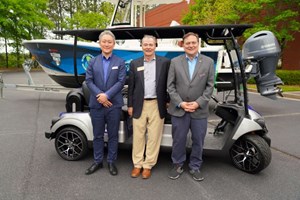News
Yamaha publicly demonstrates Yamaha H2-powered golf car
Yamaha Motor Corporation gave the first demonstration of a H2-powered golf car at the Yamaha Marine Innovation Center in Kennesaw, Georgia, following a meeting of the Georgia H2 Energy Braintrust, an organization that works with Georgia businesses, public and private partners, energy companies, universities, transportation agencies and others to elevate the state’s leadership position in H2 energy.
In early 2024, Yamaha introduced the H2-powered golf car and a H2-powered outboard as a means to explore H2 as a possible method of achieving carbon neutrality within its product lines. Yamaha’s involvement in the Braintrust underscores the company’s overall strategy to leverage multiple technology solutions to achieve carbon neutrality by 2050.
“Yamaha is exploring many ways to become carbon neutral, and H2 is one of the solutions we feel could be viable for very specific products including golf cars and larger marine outboard motors,” said Ben Speciale, President, Yamaha U.S. Marine Business Unit. “We have a significant footprint in Georgia. Working with other businesses and leaders in the state allows us to learn more about the challenges associated with the H2 distribution infrastructure. It also gives us the opportunity to work together to find solutions and gain a deeper understanding about how H2 could be a carbon-neutral option for multiple industries.”
Commissioner Echols has served on Georgia’s Public Service Commission for over a decade. His leadership in innovation includes solar, electric vehicles, smart grid technologies, biogas and nuclear energy. Echols hosts a weekly radio show called Energy Matters. In addition, he founded the Clean Energy Roadshow and the EV Braintrust.
“H2 utilization is attracting interest and investments across our country, and Georgia wants to be at the forefront,” said Georgia Public Service Commissioner Tim Echols. “It’s important for us to be able to test this technology, and Yamaha’s willingness to do this on a small scale within its product lines will help us move forward successfully as we continue to explore generation, demand, use, delivery, storage, chemicals, materials and transportation of H2.”


